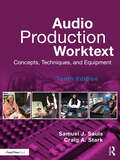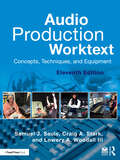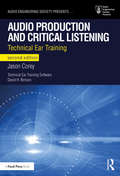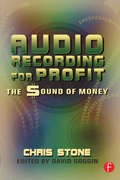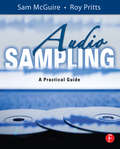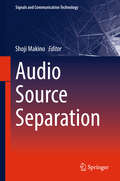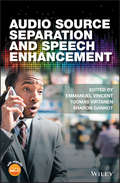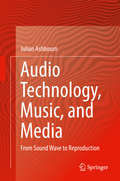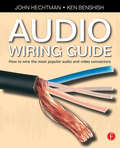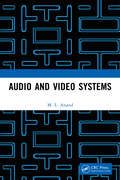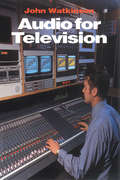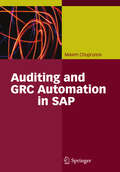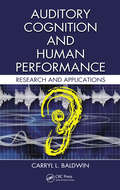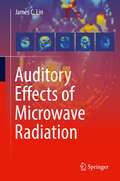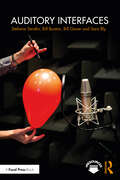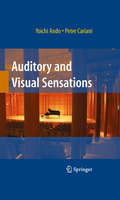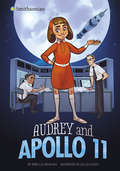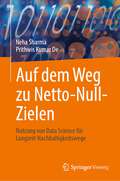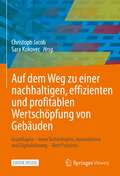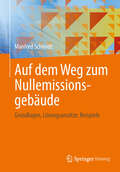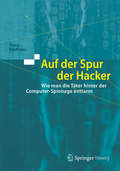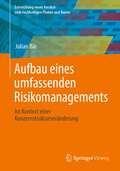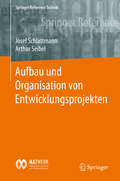- Table View
- List View
Audio Production Worktext: Concepts, Techniques, and Equipment
by Samuel J. Sauls Craig A. StarkNow in its tenth edition, the Audio Production Worktext offers a comprehensive introduction to audio production in radio, television, and film. This hands-on, student-friendly text demonstrates how to navigate modern radio production studios and utilize the latest equipment and software. Key chapters address production planning, the use of microphones, audio consoles, and sound production for the visual media. The reader is shown the reality of audio production both within the studio and on location. New to this edition is material covering podcasting, including online storage and distribution. The new edition also includes an updated glossary and appendix on analog and original digital applications, as well as self-study questions and projects that students can use to further enhance their learning. The accompanying instructor website has been refreshed and includes an instructor’s manual and PowerPoint images. This book remains an essential text for audio and media production students seeking a thorough introduction to the field.
Audio Production Worktext: Concepts, Techniques, and Equipment
by Samuel J. Sauls Craig A. Stark Lowery A. Woodall IIINow in its eleventh edition, Audio Production Worktext offers a comprehensive introduction to audio production in radio, podcasting, television, and film.This hands-on, student-friendly text demonstrates how to navigate modern radio production studios and utilize the latest equipment and software. Key chapters address production planning, the use of microphones, audio consoles, and sound production for visual media. The reader is shown the reality of audio production both within the studio and on location. In this new edition, chapters have been reorganized to address the growing prominence of podcasting and digital production. Thorough updates have been made to every chapter, including self-study questions and projects, and the authors continue to draw in diverse and international practitioner perspectives to help translate concepts to real-world practice.This book remains an essential text for audio and media production students seeking a thorough introduction to the field.The accompanying website for students and instructors has also been updated and includes sample syllabi, lesson plans, further study questions, test questions, and web resources, as well as images by chapter as included in the Worktext.
Audio Production and Critical Listening: Technical Ear Training (Audio Engineering Society Presents)
by Jason CoreyAudio Production and Critical Listening: Technical Ear Training, Second Edition develops your critical and expert listening skills, enabling you to listen to audio like an award-winning engineer. Featuring an accessible writing style, this new edition includes information on objective measurements of sound, technical descriptions of signal processing, and their relationships to subjective impressions of sound. It also includes information on hearing conservation, ear plugs, and listening levels, as well as bias in the listening process. The interactive web browser-based "ear training" software practice modules provide experience identifying various types of signal processes and manipulations. Working alongside the clear and detailed explanations in the book, this software completes the learning package that will help you train you ears to listen and really "hear" your recordings. This all-new edition has been updated to include: Audio and psychoacoustic theories to inform and expand your critical listening practice. Access to integrated software that promotes listening skills development through audio examples found in actual recording and production work, listening exercises, and tests. Cutting-edge interactive practice modules created to increase your experience. More examples of sound recordings analysis. New outline for progressing through the EQ ear training software module with listening exercises and tips.
Audio Recording for Profit: The Sound of Money
by Chris StoneThis book is the first real inside look at the business of professional audio recording, which fuels a multibillion dollar global music industry. Industry pioneer Chris Stone, founder of the legendary Record Plant, provides hard-earned business strategies, guidelines, and advice on every aspect of launching and managing a professional audio recording business. This book is for every audio profit center - from the project studio in the garage to the multi-room diversified recording facility. With 30 years of practical business experience, Mr. Stone reveals the secrets of profitable survival in the pro audio world of today and tomorrow. Why be a player in the professional audio recording industry? What is the attraction and potential payoff? How big an operation are you contemplating? To succeed, one must categorize the various types and sizes of pro audio facilities and their customer bases. It is also essential to understand creative management, marketing, promotion, and the modern economics of pro audio. The professional of tomorrow anticipates recording for new media and is prepared for diversification. All of these issues and more are addressed in this book.
Audio Sampling: A Practical Guide
by Sam McGuire Roy PrittsBringing sampling to a new generation of audio engineers and composers Audio Sampling explains how to record and create sampled instruments in a software setting. There are many things that go into creating a sampled instrument and many things that can go wrong, this book is a step by step guide through the process, from introducing sampling, where it begins to recording editing and using samples, providing much sought after detailed information on the actual process of sampling, creating sampled instruments as well as the different ways they can be used. The software used is the NN-XT a sampler that is a part of the Reason studio software and ProTools LE, however the material discussed is applicable and can be used with any sampler. The companion website has exclusive material including a comprehensive comparison of the different hardware software available, as well as audio examples and video clips from each stage of the process
Audio Source Separation (Signals And Communication Technology)
by Shoji MakinoOffers the first comprehensive treatment of audio source separation based on non-negative matrix factorization, deep neural network, and sparse component analysis.<P><P> Describes fundamentals and application of state-of-the-art audio source separation techniques.<P> Presents a comprehensive, authoritative, and accessible treatment to the subject matter.<P>This book provides the first comprehensive overview of the fascinating topic of audio source separation based on non-negative matrix factorization, deep neural networks, and sparse component analysis.<P> The first section of the book covers single channel source separation based on non-negative matrix factorization (NMF). After an introduction to the technique, two further chapters describe separation of known sources using non-negative spectrogram factorization, and temporal NMF models. In section two, NMF methods are extended to multi-channel source separation. Section three introduces deep neural network (DNN) techniques, with chapters on multichannel and single channel separation, and a further chapter on DNN based mask estimation for monaural speech separation. In section four, sparse component analysis (SCA) is discussed, with chapters on source separation using audio directional statistics modelling, multi-microphone MMSE-based techniques and diffusion map methods.<P> The book brings together leading researchers to provide tutorial-like and in-depth treatments on major audio source separation topics, with the objective of becoming the definitive source for a comprehensive, authoritative, and accessible treatment. This book is written for graduate students and researchers who are interested in audio source separation techniques based on NMF, DNN and SCA.
Audio Source Separation and Speech Enhancement
by Tuomas Virtanen Emmanuel Vincent Sharon GannotLearn the technology behind hearing aids, Siri, and Echo Audio source separation and speech enhancement aim to extract one or more source signals of interest from an audio recording involving several sound sources. These technologies are among the most studied in audio signal processing today and bear a critical role in the success of hearing aids, hands-free phones, voice command and other noise-robust audio analysis systems, and music post-production software. Research on this topic has followed three convergent paths, starting with sensor array processing, computational auditory scene analysis, and machine learning based approaches such as independent component analysis, respectively. This book is the first one to provide a comprehensive overview by presenting the common foundations and the differences between these techniques in a unified setting. Key features: Consolidated perspective on audio source separation and speech enhancement. Both historical perspective and latest advances in the field, e.g. deep neural networks. Diverse disciplines: array processing, machine learning, and statistical signal processing. Covers the most important techniques for both single-channel and multichannel processing. This book provides both introductory and advanced material suitable for people with basic knowledge of signal processing and machine learning. Thanks to its comprehensiveness, it will help students select a promising research track, researchers leverage the acquired cross-domain knowledge to design improved techniques, and engineers and developers choose the right technology for their target application scenario. It will also be useful for practitioners from other fields (e.g., acoustics, multimedia, phonetics, and musicology) willing to exploit audio source separation or speech enhancement as pre-processing tools for their own needs.
Audio Technology, Music, and Media: From Sound Wave to Reproduction
by Julian AshbournThis book provides a true A to Z of recorded sound, from its inception to the present day, outlining how technologies, techniques, and social attitudes have changed things, noting what is good and what is less good. The author starts by discussing the physics of sound generation and propagation. He then moves on to outline the history of recorded sound and early techniques and technologies, such as the rise of multi-channel tape recorders and their impact on recorded sound. He goes on to debate live sound versus recorded sound and why there is a difference, particularly with classical music. Other topics covered are the sound of real instruments and how that sound is produced and how to record it; microphone techniques and true stereo sound; digital workstations, sampling, and digital media; and music reproduction in the home and how it has changed. The author wraps up the book by discussing where we should be headed for both popular and classical music recording and reproduction, the role of the Audio Engineer in the 21st century, and a brief look at technology today and where it is headed. This book is ideal for anyone interested in recorded sound. “[Julian Ashbourn] strives for perfection and reaches it through his recordings… His deep knowledge of both technology and music is extensive and it is with great pleasure that I see he is passing this on for the benefit of others. I have no doubt that this book will be highly valued by many in the music industry, as it will be by me.” -- Claudio Di Meo, Composer, Pianist and Principal Conductor of The Kensington Philharmonic Orchestra, The Hemel Symphony Orchestra and The Lumina Choir
Audio Wiring Guide: How to wire the most popular audio and video connectors
by John HechtmanWhether you're a pro or an amateur, a musician or into multimedia, you can't afford to guess about audio wiring. The Audio Wiring Guide is a comprehensive, easy-to-use guide that explains exactly what you need to know. No matter the size of your wiring project or installation, this handy tool provides you with the essential information you need and the techniques to use it. Using The Audio Wiring Guide is like having an expert at your side. By following the clear, step-by-step directions, you can do professional-level work at a fraction of the cost. Every step is clearly explained and photo-illustrated. All the common audio connectors are covered as well as most special-use multimedia connectors. It is the perfect guide to keep by your side in the studio or on the road.
Audio and Speech Processing with MATLAB
by Paul HillSpeech and audio processing has undergone a revolution in preceding decades that has accelerated in the last few years generating game-changing technologies such as truly successful speech recognition systems; a goal that had remained out of reach until very recently. This book gives the reader a comprehensive overview of such contemporary speech and audio processing techniques with an emphasis on practical implementations and illustrations using MATLAB code. Core concepts are firstly covered giving an introduction to the physics of audio and vibration together with their representations using complex numbers, Z transforms and frequency analysis transforms such as the FFT. Later chapters give a description of the human auditory system and the fundamentals of psychoacoustics. Insights, results, and analyses given in these chapters are subsequently used as the basis of understanding of the middle section of the book covering: wideband audio compression (MP3 audio etc.), speech recognition and speech coding. The final chapter covers musical synthesis and applications describing methods such as (and giving MATLAB examples of) AM, FM and ring modulation techniques. This chapter gives a final example of the use of time-frequency modification to implement a so-called phase vocoder for time stretching (in MATLAB). Features A comprehensive overview of contemporary speech and audio processing techniques from perceptual and physical acoustic models to a thorough background in relevant digital signal processing techniques together with an exploration of speech and audio applications. A carefully paced progression of complexity of the described methods; building, in many cases, from first principles. Speech and wideband audio coding together with a description of associated standardised codecs (e.g. MP3, AAC and GSM). Speech recognition: Feature extraction (e.g. MFCC features), Hidden Markov Models (HMMs) and deep learning techniques such as Long Short-Time Memory (LSTM) methods. Book and computer-based problems at the end of each chapter. Contains numerous real-world examples backed up by many MATLAB functions and code.
Audio and Video Systems
by M. L. AnandThis book details the important concepts in the study of audio and video systems. It covers the basics of audio and video engineering, communication and radar systems, optical fibers, and consumer electronics. It is aimed at B. Tech and Diploma students and also includes assessment questions for better understanding and practice.The subject matter of this book also discusses: Sound Synthesis Need of F.M. (Frequency Modulation) for Video Recording Turnstile Array Delta Gun Colour Picture Tube Snell’s Law Print edition not for sale in South Asia (India, Sri Lanka, Nepal, Bangladesh, Pakistan or Bhutan)
Audio for Television
by John WatkinsonAudio for Television outlinines all the relevant principles and practices. Newcomers to the field will find it an invaluable, up to date resource and experienced sound people will gain from the explanations of new technology. The rate of change in the technology of television sound has recently accelerated to such a degree that it is now a sufficiently expansive subject to warrant a book of its own. These rapid changes, from the introduction first of stereo, then multi-channel or surround sound, have made it difficult for those working in this field to keep up with the technology and even harder for those just setting out on a career in television sound.The book considers analog and digital audio as alternatives and stresses the advantages of both. Microphone and loudspeaker technology is also discussed in some detail and audio recording and routing and transmission are also covered.
Audiovisual Archives: Digital Text and Discourse Analysis
by Peter StockingerToday, audiovisual archives and libraries have become very popular especially in the field of collecting, preserving and transmitting cultural heritage. However, the data in these archives or libraries - videos, images, soundtracks, etc. - constitute as such only potential cognitive resources for a given public (or “target community”). One of the most crucial issues of digital audiovisual libraries is indeed to enable users to actively appropriate audiovisual resources for their own concern (in research, education or any other professional or non-professional context). This means, an adaptation of the audiovisual data to the specific needs of a user or user group can be represented by small and closed "communities" as well as by networks of open communities around the globe. "Active appropriation" is, basically speaking, the use of existing digital audiovisual resources by users or user communities according to their expectations, needs, interests or desires. This process presupposes: 1) the definition and development of models or "scenarios" of cognitive processing of videos by the user; 2) the availability of tools necessary for defining, developing, reusing and sharing meta-linguistic resources such as thesauruses, ontologies or description models by users or user communities. Both aspects are central to the so-called semiotic turn in dealing with digital (audiovisual) texts, corpora of texts or again entire (audiovisual) archives and libraries. They demonstrate practically and theoretically the well-known “from data to metadata” or “from (simple) information to (relevant) knowledge” problem, which obviously directly influences the effective use, social impact and relevancy, and therefore also the future, of digital knowledge archives. This book offers a systematic, comprehensive approach to these questions from a theoretical as well as practical point of view. Contents Part 1. The Practical, Technical and Theoretical Context 1. Analysis of an Audiovisual Resource. 2. The Audiovisual Semiotic Workshop (ASW) Studio – A Brief Presentation. 3. A Concrete Example of a Model for Describing Audiovisual Content. 4. Model of Description and Task of Analysis. Part 2. Tasks in Analyzing an Audiovisual Corpus 5. The Analytical Task of “Describing the Knowledge Object”. 6. The Analytical Task of “Contextualizing the Domain of Knowledge”. 7. The Analytical Task of “Analyzing the Discourse Production around a Subject”. Part 3. Procedures of Description 8. Definition of the Domain of Knowledge and Configuration of the Topical Structure. 9. The Procedure of Free Description of an Audiovisual Corpus. 10. The Procedure of Controlled Description of an Audiovisual Corpus. Part 4. The ASW System of Metalinguistic Resources 11. An Overview of the ASW Metalinguistic Resources. 12. The Meta-lexicon Representing the ASW Universe of Discourse.
Auditing and GRC Automation in SAP
by Maxim ChuprunovOver the last few years, financial statement scandals, cases of fraud and corruption, data protection violations, and other legal violations have led to numerous liability cases, damages claims, and losses of reputation. As a reaction to these developments, several regulations have been issued: Corporate Governance, the Sarbanes-Oxley Act, IFRS, Basel II and III, Solvency II and BilMoG, to name just a few. In this book, compliance is understood as the process, mapped not only in an internal control system, that is intended to guarantee conformity with legal requirements but also with internal policies and enterprise objectives (in particular, efficiency and profitability). The current literature primarily confines itself to mapping controls in SAP ERP and auditing SAP systems. Maxim Chuprunov not only addresses this subject but extends the aim of internal controls from legal compliance to include efficiency and profitability and then well beyond, because a basic understanding of the processes involved in IT-supported compliance management processes are not delivered along with the software. Starting with the requirements for compliance (Part I), he not only answers compliance-relevant questions in the form of an audit guide for an SAP ERP system and in the form of risks and control descriptions (Part II), but also shows how to automate the compliance management process based on SAP GRC (Part III). He thus addresses the current need for solutions for implementing an integrated GRC system in an organization, especially focusing on the continuous control monitoring topics. Maxim Chuprunov mainly targets compliance experts, auditors, SAP project managers and consultants responsible for GRC products as readers for his book. They will find indispensable information for their daily work from the first to the last page. In addition, MBA, management information system students as well as senior managers like CIOs and CFOs will find a wealth of valuable information on compliance in the SAP ERP environment, on GRC in general and its implementation in particular.
Auditory Cognition and Human Performance: Research and Applications
by Carryl L. BaldwinHearing and understanding sound- auditory processing- greatly enriches everyday life and enhances our ability to perform many tasks essential to survival. The complex soundscape in which we live influences where we direct our attention, how we communicate with each other, and how we interact with technological systems. Auditory Cognition and Human
Auditory Effects of Microwave Radiation
by James C. LinThis book examines the human auditory effects of exposure to directed beams of high-power microwave pulses, which research results have shown can cause a cascade of health events when aimed at a human subject or the subject’s head. The book details multidisciplinary investigations using physical theories and models, physiological events and phenomena, and computer analysis and simulation. Coverage includes brain anatomy and physiology, dosimetry of microwave power deposition, microwave auditory effect, interaction mechanisms, shock/pressure wave induction, Havana syndrome, and application in microwave thermoacoustic tomography (MTT). The book will be welcomed by scientists, academics, health professionals, government officials, and practicing biomedical engineers as an important contribution to the continuing study of the effects of microwave pulse absorption on humans.
Auditory Interfaces
by Bill Buxton Stefania Serafin Bill Gaver Sara BlyAuditory Interfaces explores how human-computer interactions can be significantly enhanced through the improved use of the audio channel. Providing historical, theoretical and practical perspectives, the book begins with an introductory overview, before presenting cutting-edge research with chapters on embodied music recognition, nonspeech audio, and user interfaces. This book will be of interest to advanced students, researchers and professionals working in a range of fields, from audio sound systems, to human-computer interaction and computer science.
Auditory and Visual Sensations
by Yoichi Ando Peter CarianiAndo establishes a theory of subjective preference of the sound field in a concert hall, based on preference theory with a model of human auditory- brain system. The model uses the autocorrelation function and the interaural crosscorrelation function for signals arriving at two ear entrances and considers the specialization of human cerebral hemispheres. The theory may be applied to describe primary sensations such as pitch or missing fundamental, loudness, timbre, and duration. The theory may also be applied to visual sensations as well as subjective preference of visual environments. Remarkable findings in activities in both auditory-brain and visual-brain systems in relation to subjective preference as a primitive response are described.
Audrey and Apollo 11 (Smithsonian Historical Fiction)
by Rebecca RissmanScience-obsessed Audrey is a fifth grader in Houston, Texas, who dreams of one day working at NASA, like her dad does. Dad, however, is nothing but discouraging. Audrey doesn't give up, though. She's created her own model rocket. When it doesn't fly, she figures out a way to fix it that ends up helping the Apollo 11 astronauts after they land on the Moon. Will Audrey's dad come around? And will Audrey have a future in science?
Auf dem Weg zu Netto-Null-Zielen: Nutzung von Data Science für Langzeit-Nachhaltigkeitswege
by Neha Sharma Prithwis Kumar DeDieses Buch diskutiert die Verwendung von Technologie, Data Science und Open Data, um das Netto-Null-Emissionsziel des Pariser Abkommens zum Klimawandel zu erreichen. Es gibt viele Diskussionen über Nachhaltigkeit und Lösungen für den Klimawandel, um die negativen Auswirkungen zu mildern. Die Verwendung von Technologiehebeln zur Bewältigung von Klimaherausforderungen wird jedoch selten als der bedeutendste Katalysator betrachtet. Die verfügbare Forschung in diesem Bereich ist im Allgemeinen qualitativer Natur, bei der Technologie und Daten noch nicht genutzt wurden. Durch den Einsatz von KI/ML sagt das Buch die Klimawandelfolgen aufgrund von Investitionen in den fossilen Brennstoffsektor voraus, schätzt die CO2-Emissionen des Verkehrssektors, prognostiziert die durch nicht erneuerbare Energiequellen verursachte durchschnittliche Landtemperatur und segmentiert indische Bundesstaaten auf der Grundlage von Haushalts-CO2-Emissionen. Die Forscher, Entscheidungsträger, Studenten, Lehrer, Bildungseinrichtungen, Regierungen, Regulierungsbehörden, Unternehmen, internationale Organisationen usw. werden immens von diesem Buch profitieren. Darüber hinaus soll dieses Buch dazu dienen, den nächsten Generationen eine dekarbonisierte Umgebung und eine bessere Zukunft zu bieten.
Auf dem Weg zu einer nachhaltigen, effizienten und profitablen Wertschöpfung von Gebäuden: Grundlagen – neue Technologien, Innovationen und Digitalisierung – Best Practices
by Christoph Jacob Sara KukovecBei vielen Fragen rund um nachhaltige Profitabilität- und Produktivitätssteigerungen der Bau- und Immobilienwirtschaft unterstützt dieses Werk die Leser*innen, durch Einsatz digitaler Tools und Innovationen, die Dynamik der gesamten Prozesse deutlich zu verbessern. Dieses Buch hilft die möglichen Potentiale aktiv zu nutzen, um nachhaltig zu handeln, Kosten zu reduzieren und Unternehmen/Bereiche/Abteilungen in eine sichere profitable Zukunft zu führen.
Auf dem Weg zum Nullemissionsgebäude: Grundlagen, Lösungsansätze, Beispiele
by Manfred SchmidtEnergie erzeugende Gebäude erzeugen die zu ihrem Betrieb benötigte Energie zum Teil oder gänzlich selbst. Um die dafür benötigte Energie zu quantifizieren, werden die nötigen Bedingungen für das Raumklima und den Gebäudeerhalt und der sich daraus ergebende Energiebedarf für Gebäude dargestellt. Die Anlagen zur Gebäudeenrgieversorgung und die Strategien ihrer Bemessung werden erläutert. Wegen des stochastischen Charakters der zur Energieversorgung bereit stehenden Energien wird auf die Rolle von Energiespeichern, den Speichermedien und deren Rückwirkung auf die Gebäudegestaltung einzugehen. Die Klassifikation von Niedrig- bzw. Nullemissionshäusern, relevante Beispiele und deren betriebswirtschaftliche Bewertung schließen das Buch ab.
Auf der Spur der Hacker
by Timo SteffensProfessionelle Hackerangriffe (sogenannte Advanced Persistent Threats) treffen heutzutage Regierungen, Unternehmen und sogar kritische Infrastrukturen wie Flughäfen oder Stromnetzbetreiber. Herauszufinden, welche Täter und Auftraggeber dahinter stecken, wird zunehmend wichtiger. Wenn man die Ursprünge eines Angriffs und seine Motive kennt, kann man sich besser schützen und die Konsequenzen eines Datendiebstahls effektiver begrenzen.Damit die Frage, ob ein Angriff aus Russland, China, einem anderen Land, oder von gewöhnlichen Kriminellen durchgeführt wurde, nicht eine Frage des Glaubens oder Bauchgefühls bleibt, soll dieses Buch einen Blick hinter die Kulissen der Ermittler und Analysten werfen. Ausführlich erläutert der Autor die IT-technischen Methoden, mit denen man den Tätern auf die Spur kommt, aber auch, wo diese Methoden an Grenzen stoßen. Zahlreiche Beispiele von aufwändigen Angriffen der letzten Jahre zeigen, wie die Täter falsche Fährten legen, oft genug aber auch Fehler machen, die sie überführen.So bietet der Autor, der seit mehreren Jahren gezielte Hackerangriffe von Spionagegruppen auf Behörden und Unternehmen untersucht, einen spannenden Blick hinter die Kulissen der Ermittler und Analysten. Neben Sicherheitsexperten staatlicher Behörden, Unternehmen, Stiftungen und NGOs, die regelmäßig zum Ziel von Cyberkriminalität werden, finden auch technische Journalisten und interessierte Laien in diesem Buch eine Fülle an Hintergrundwissen zur IT-Forensik.
Aufbau eines umfassenden Risikomanagements: Im Kontext einer Konzernstrukturveränderung (Entwicklung neuer Ansätze zum nachhaltigen Planen und Bauen)
by Julian BärZunehmende Kapitalmarktverpflechtungen, fortschreitende Digitalisierung, Globalisierung der Wertschöpfungsketten, die Notwendigkeit zum Aufbau nachhaltiger Lieferketten, neue Dynamiken im Mergers and Acquisitions-Geschäft und individuelle Interessen, Kenntnisse und Leistungen der Unternehmensmitglieder kennzeichnen die Risikosituation vieler Unternehmen. Kann dieser komplexen Situation mit einem einfachen Ansatz begegnet werden? Die vorliegende Ausarbeitung entwirft unter dem Stichwort umfassendes Risikomanagement ein Konzept, welches dieser Komplexität eine pragmatische und klar strukturierte Vorgehensweise gegenüberstellt. Der Autor setzt hierbei auf Perspektivenvielfalt in Form einer interdisziplinären Zusammenarbeit im Unternehmen und berücksichtigt ganz bewusst Einflüsse auf, Verzerrungen von und Abweichungen zu einer rationalen Vorgehensweise beteiligter Parteien in zentralen Geschäftsentscheidungen. Mit einer strukturierten Informations- und Datensammlung aus verschiedenen Managementdisziplinen (z. B. Controlling, Qualitätsmanagement, Risikomanagement, etc.) sowie einer zur Analyse und Beurteilung der Ergebnisse geeigneten Dokumentation wird eine Grundlage für risikobewusste und rational orientierte Entscheidungen im Bauprojektgeschäft entwickelt.Das Konzept eignet sich für den Aufbau, die Neustrukturierung oder eine grundlegende Anpassung von Risikomanagementsystemen in projektorientierten Unternehmen. Es zeichnet sich durch eine zielgerichtete und übersichtliche Struktur aus und ermöglicht durch an Projekten und Unternehmenseinheiten ausgerichtete Prozesse eine flexible Anpassung an Unternehmens- bzw. Konzernstrukturen. Inhaltlich bezieht sich die Ausarbeitung auf grundlegenden Daten, Faktoren und Einflüsse, die neben den Akquisitionsentscheidungen der Bauprojekterstellung auch die Prozesse strategischer Investitions- oder Geschäftsfeldentscheidungen kennzeichnen.
Aufbau und Organisation von Entwicklungsprojekten (Springer Reference Technik)
by Josef Schlattmann Arthur SeibelZiel dieses Handbuchs ist die Vermittlung von nutzbringenden Kenntnissen, F#65533;higkeiten und Verhaltensweisen, die ein in der Produktentwicklung/Projektleitung verantwortlich t#65533;tiger Ingenieur vielfach braucht, die aber in der #65533;blichen Ingenieurausbildung zu wenig Beachtung finden. Sie greifen #65533;ber das Fachwissen hinaus in den menschlichen Bereich hinein, weil technischen und/oder organisatorischen Schwierigkeiten faktisch immer menschliche Probleme zugrunde liegen.
